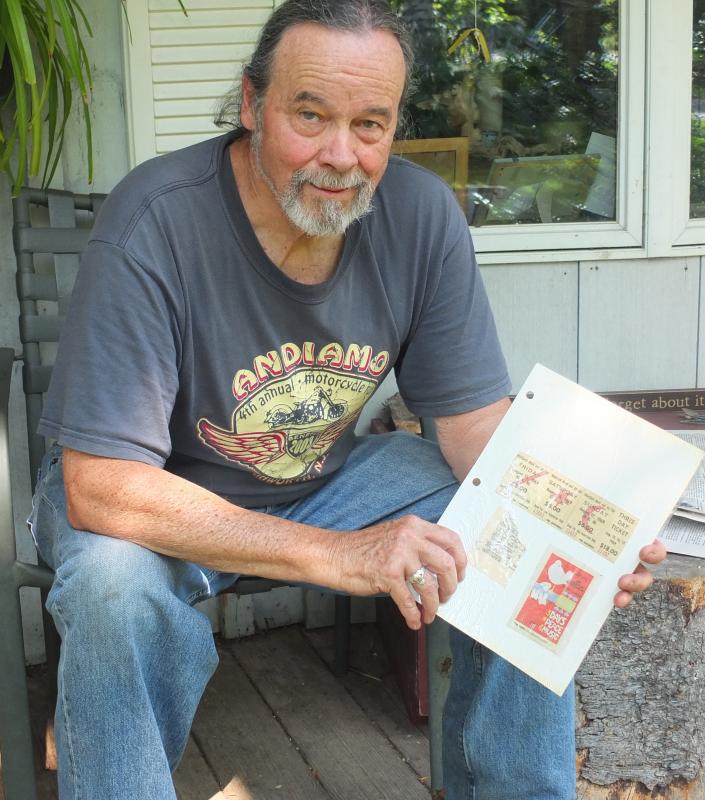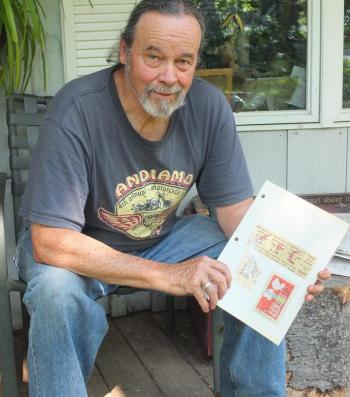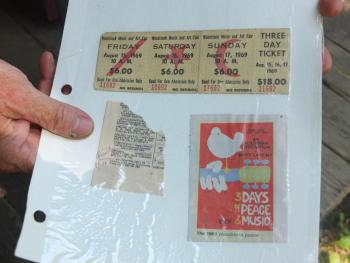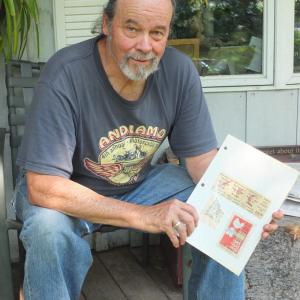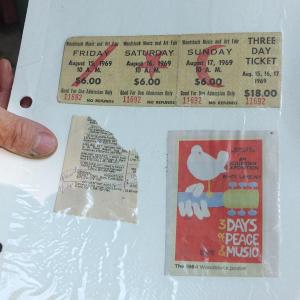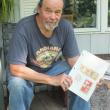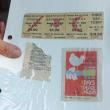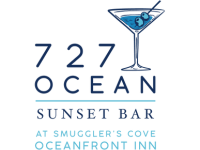Memories of the 1969 Woodstock music festival
On a recent warm August day, Tim Hanley sat on his front porch in Southport and reflected on what he did in the summer of 1969. Hanley was 19 years old living in Bergen County, New Jersey working as a lifeguard, earning money for college. He was also one of over 400,000 who attended the iconic American music festival, Woodstock. As he talked about the three-day music festival, he displayed a souvenir from that historic weekend. Hanley still has the ticket he bought.
“It cost $18 for three days. I don’t know what it cost in today’s money, but in 1969, $18 was hard to come by, and I bought one for me and one for my girlfriend.” Hanley attended the festival, but the ticket went unredeemed. It seemed Woodstock Ventures, a corporation formed by four New York twenty-something year-olds, saw the concert as an East Coast version of 1967’s Monterey Pop Festival in California. Woodstock Ventures envisioned 50,000 attendees at Howard Mills Industrial Park in Wallkill, New York, 70 miles north of New York City.
Instead, a crowd nearly 10 times that size arrived at a different venue. Wallkill officials rescinded permits for the festival, and Woodstock Ventures took the concert to Max Yasgur’s dairy farm in Bethel, New York, 112 miles from NYC. The attendance miscalculation materialized on Aug. 15, 1969 as an onslaught of traffic headed up New York State Route 17 B toward Yasgur’s farm. This created a logistical problem for everyone involved even before the first act took the stage at 5 p.m.
But the overwhelming traffic didn’t bother Hanley. He hopped on his Honda motorcycle with his girlfriend and made the trip from Bergen County to Bethel, New York in three hours. “I saw the traffic and just weaved around it until we arrived at Woodstock. It took longer for our friends who traveled in a van,” he said. Once Hanley arrived, he witnessed a massive crowd with nobody to take his ticket.
The unexpected crowd was a windfall for hundreds of thousands of Woodstock attendees. One of those was Boothbay resident Brad Hastings, who has lived in the peninsula since 2011. But in 1969, he, like Hanley, was a 19-year-old college student. Hastings and friend Chris O’Neil left Greenwich, Connecticut in a borrowed English TR 3 Triumph roadster. “Our plan was to buy tickets at the gate, but we got there and there was no gate. So we just went in,” Hastings said .
The first performer was Richie Havens, a 28-year-old folk, soul and rhythm and blues performer known for his intensive guitar playing style. His 45-minute performance included the song he is best known for, “Freedom.”
Sweetwater was the first scheduled act, but the folk singing group was stuck in traffic. Havens took the stage performing planned and vamped material. “They were stalling because several acts were stuck in traffic so he kept playing, and eventually performed ‘Freedom.’ He went on and on and started making up new lyrics. And years later, I learned he had to watch the film to recreate all the words,” Hastings said.
Havens was followed by Bert Sommer, Sweetwater, Melanie, Tim Harden, Ravi Shankar, and Arlo Guthrie. Joan Baez concluded the opening session at 2 a.m. Saturday. Day two started at 12:15 p.m. with Quill followed by Country Joe and the Fish who played the song that became an immediate hit with the Woodstock generation, “What Are We Fighting For?” Country Joe may not have had the staying power of Creedence Clearwater Revival or Crosby, Stills, Nash and Young, but on that day, Country Joe had the biggest impact.
“What Are We Fighting For” became a protest song most identified with the anti-war movement. For Hanley, he worried about his draft status. He feared losing his student draft deferment. As a college student, Hanley didn’t consider himself an activist, but he was dead set against the war. “I really identified with that song. We all had Vietnam bearing down on you along with the lying cabinet of Nixon, which I never thought would be duplicated, until now, where we have someone worse,” he said.
Hastings was also against the war, but on that weekend, it wasn’t on his mind until the crowd sang along with Country Joe. “I was a typical kid there just to have a good time, but when Country Joe began singing that song everybody just erupted. It was really the high point (of Woodstock),” Hastings said.
While Country Joe and the Fish seized the moment at Woodstock, Crosby, Stills, Nash and Young captured the Woodstock generation. The band was a vocal folk rock supergroup noted for its intricate vocal harmonies. Hanley and Hastings agreed the band most attendees wanted to see was CSNY.
“It was like their second time playing in public and it was wonderful,” Hanley said. “They were a special band and made some wonderful music. Very soothing. They were a great contrast to Beatles and Rolling Stones.” For Hastings , hearing the song “Suite Judy Blue Eyes” was an amazing experience. “So many great bands there, but my favorite was CSNY. The three were very popular, but when Neil Young joined, it went to another level,” he said.
Tom Witt and Barbara Scorcia are two other current Boothbay residents who attended Woodstock, but neither saw much of the show or remember it. Witt was 19 and working in Boothbay Harbor for the summer. His friend Mark Royal was going to Woodstock and took Witt along. Witt’s most vivid memories were captured in 35mm film shot by Royal. The film shows helicopters leaving the venue, a giant peace sign and naked girls dancing.
So why doesn’t Witt remember such an iconic moment? “You know what they say, if you remember the sixties, then you probably weren’t there, and that fits me,” Witt said.
Scorcia was a 19-year-old New York University student living in Brooklyn. She was a major music fan and was excited for Woodstock and seeing Country Joe and the Fish, Janis Joplin and Richie Havens. Scorcia and her sister bought tickets and headed with their boyfriends to Woodstock.
But they got a late start and arrived after the festival started. A torrential rain hit and they all headed to a nearby cabin. “Didn’t see any of it. The only group we saw was the ‘Cellar Dwellers’ which was the two boys who were our dates. We sat around the campfire and the boys played their guitars and sang,” she said.
But Hastings and Hanley do have lasting memories. Hanley remembers the enormous crowd and everybody being on top of one another. “Lying in a field with nudes walking all around. One guy was naked and walking a goat. Despite all the chaos, everyone respected each other. It was a true adrenaline rush being there, and it changed my life,” he said.
Hastings’ most memorable moment occurred during Jefferson Airplane’s performance. The second day began on Saturday, Aug. 16 at 12:15 p.m. and concluded at 9:45 a.m. on Aug. 17. Jefferson Airplane was one of the last acts that morning. “Nobody was sleeping and I remember Sly and the Family Stone had everybody up and jumping that night, but when Gracie Slick took the stage, and said ‘Morning people, you’ve seen the heavy groups. Now you’ll see some morning maniac music,’ that was awesome,” Hastings said.
Even though Witt doesn’t remember much about Woodstock, he described it as a watershed moment in history. “Before Woodstock, the country was very conservative driven. Now it’s more uninhibited, more honest. We live in a time where people truly care about one another,” he said.
One of the most iconic performances at Woodstock was Jimi Hendrix who closed the show and played his version of the “Star Spangled Banner” on the electric guitar. It became a moment which exemplified the generation gap between the country’s older establishment-types and the younger counter culture. By the time Hendrix took the stage, it was Monday morning and Hastings, Hanley, Scorcia and Witt were all on their way home.
Event Date
Address
United States

